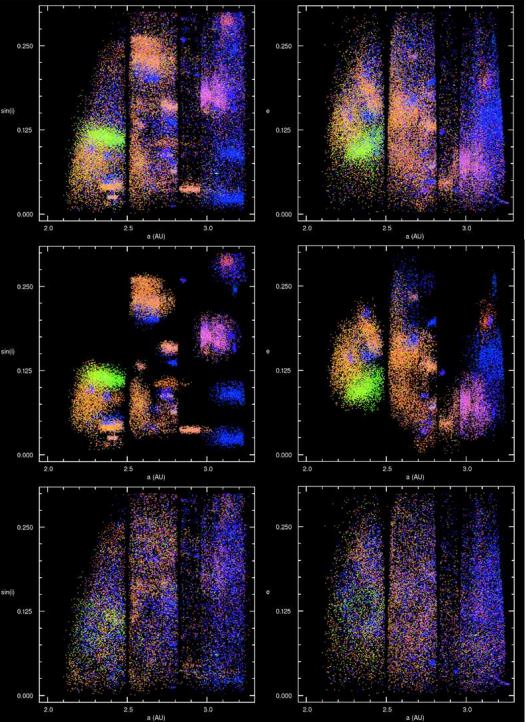Who knew asteroids could be so beautiful and mesmerizing? In 2008, a group of astronomers led by Alex Parker did a study of the size distribution of asteroid families using data from the Sloan Digital Sky Survey. Asteroid families often have distinctive optical colors, the team said, and they were able to offer an improved way to separate out the family members into their colors. This resultant animation put together just this week by Parker shows the orbital motions of over 100,000 asteroids, with colors illustrating the compositional diversity and relative sizes of the asteroids.
“The compositional gradient of the asteroid belt is clearly visible,” says Parker, “with green Vesta-family members in the inner belt fading through the blue C-class asteroids in the outer belt, and the deep red Trojan swarms beyond that.”
All main-belt asteroids and Trojan asteroids with orbits known to high precision are shown in the video and the animation is rendered with a timestep of 3 days. Via Twitter, Parker said this animation took — from start to finish — 20 hours to render on 8 CPUs.
For reference, the average orbital distances of Mercury, Venus, Earth, Mars, and Jupiter are illustrated with rings.
Painted Stone: Asteroids in the Sloan Digital Sky Survey from Alex Parker on Vimeo.


You can run this kind of visualization on your own PC at 100+ fps (depending on your video card and settings)
https://sourceforge.net/projects/openclsolarsyst/
I’m only using the asteroid types from the MPC for colouring.
I’ll see if I can incorporate the colours from this study.
Mesmerizing is right. Seeing those little dots cross paths with Earth makes me want to practice duck & hide. I’m off to find out about those Trojans. Very asymmetrical? Thanks for the show.
It’s a great time to be alive, innit?! Well, 100 years hence might be better…or 1000.
I wonder though about the two large blobs that show up at (say) 120° and 240°? are there missing data at 0°? Or?
No, it’s not missing data. Those are asteroids orbiting around the L4 and L5 Lagrangian points of Jupiter and the Sun. That’s why they look like two blobs. This video doesn’t show where Jupiter is, but it’s on the orbit right between the two blobs 🙂 http://upload.wikimedia.org/wikipedia/commons/f/f3/InnerSolarSystem-en.png
oTay then… Which of these asteroids contain useful elements? That is to say, which group shows the most promise and is worthy of a closer look?
I like the idea of sending swarms (tens of thousands) of solar wind sailing nanobots to explore the more interesting asteroids. The nanobots ‘shot’ into space via a mountaintop solar powered rail gun to reduce launch costs?
We already know some important answers without fantasy launchers that will incinerate upon launch. Ceres is mostly water. Psyche is likely an exposed core full of metals.
Thank you Universe Today for posting a Vimeo video and not an ad-ridden YouTube atrocity!
Absolutely one of the BEST and most informative sims I’ve seen. For instance, I FINALLY get Jupiter’s trojans! And the little swarm that buzz around even inside the orbit of Mercury is fascinating to watch as well… Thanks, Nancy!